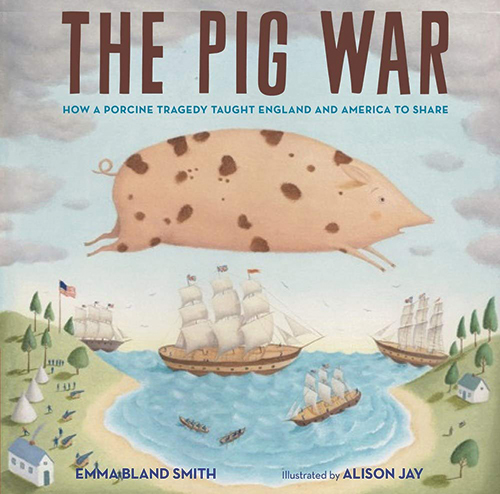
The Pig War: How a Porcine Tragedy Taught England and America to Share
By Emma Bland Smith, illustrated by Alison Jay. Calkins Creek, 2020. 48 pages. $18.99/hardcover; $11.99/eBook. Recommended for ages 7–10.
It is late spring 1859, and off the coast of what’s now Washington State, on a tiny and beautiful island in the Pacific Ocean, the United States and Great Britain are about to go to war.
Because a farmer shot another farmer’s pig.
Yes, you read that correctly. No, this is not fiction. And no, you’ve probably never heard this story before, unless you live in the Pacific Northwest, and even then . . . But all that, along with a lot of other things, is the charm of The Pig War, a tiny episode from U.S. history that passed most of us by in history class. It is a story that could have had huge implications, which remarkably—considering so much of our country’s violent history—was settled with only two shots being fired. And nobody was killed: well . . . except the pig.
As White people moved west in the 1850s, displacing Indigenous people, carving out new territories, and establishing new states, the area of the Pacific Northwest was something of a no-man’s land, with the United States and Great Britain claiming various regions and sharing territory in others. One of those areas was San Juan Island, which sits roughly equidistant between what are now Seattle and Vancouver. Here the two groups maintained a peaceful community, each group trying to carve out an existence without getting into the other’s way.
Until one morning, when a “British” pig started uprooting an American farmer’s potatoes. That is when peaceful coexistence fell apart; armies and navies were mustered; governments began harrumphing at each other; and two great and heavily armed nations prepared to go to war for the third time in less than 100 years.
But they didn’t. After a rather frightening escalation (at first involving the soon-to-be-famous George Pickett), cooler heads prevailed, and not only was war averted, but the two communities actually got along better than before.
How that all unfolded is told in brisk and charmingly snarky prose by American writer Emma Bland Smith. (This book would definitely make for a fun read-aloud in any teacher’s classroom.) But for me, the folk-art-inspired illustration by British artist Alison Jay is what really makes the book special. The illustrations in this large-format book stretch over two pages, and the reader will definitely want to take time as each page is turned to savor all the details. The author’s notes at the end of the book include actual photographs from the period, along with a lot more historical detail, a timeline, and a list of additional resources.
But let’s go back for just one second.
Yes, an American and a Brit collaborated on this lovely book. How perfect!
David Austin is a member of Haddonfield (N.J.) Meeting and a retired educator. His middle-grade novel in verse recounting the true story of Holocaust survivor Charles Middleberg is titled Small Miracle and is now available from Fernwood Press.


